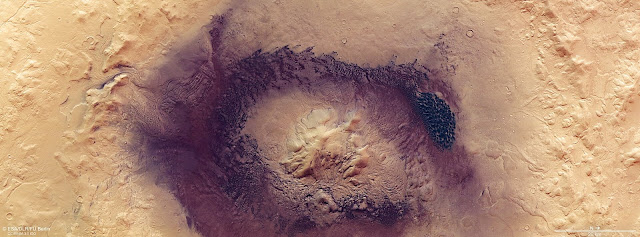ESA - Mars Express Mission patch.
March 5, 2020
The dark dunes of Moreux crater
Known for its wide swathes of rippling, textured, gently sloping dunes, the Terra Sabaea region on Mars is home to many fascinating geological features – including the prominent Moreux crater, the star of a new image from ESA’s Mars Express.
The Moreux crater on Mars showcases numerous intriguing geological processes and features. It sits at the northern edge of Terra Sabaea, a large area of the Red Planet that is speckled with impact craters and covered in glacial flows, dunes, fretted terrain and intricate ridge networks.
Mars Express
When compared to other impact craters on both Mars and Earth, Moreux crater appears a little misshapen and messy – the result of ongoing erosion over martian history. Its egg-shaped rim is broken up, its dark walls are ridged, rippled and mottled, and its centre features a prominent clustered ‘peak’, created as material from the crater floor rebounded and rose upwards following the initial impact.
The topography of Moreux crater
It is difficult to get a sense of scale when viewing this peak from orbit, but Moreux crater’s central peak is sizeable, reaching around two kilometres in height. The crater itself is roughly three kilometres deep, and spans 135 kilometres from edge to edge.
The range of colours featured in images like this one, taken by the High Resolution Stereo Camera on Mars Express, reveals much about the composition of a particular region, material or feature.
In the case of Moreux crater, the colour differences are stark: while the surrounding material is visible in hues of butterscotch and caramel, the crater’s walls are dark, resembling a smudged ring of ash or charcoal. Dark brown and black dunes cover the crater floor, while the peak remains a pale yellow-orange. Dark, prominent ejecta, comprising material flung outwards during the crater-forming collision, spread outwards from the crater rim, discolouring and encroaching upon the lighter surrounding terrain.
Perspective view of Moreux crater
This varied colour palette reflects an equally varied geological composition. The dunes within and around the crater are thought to contain sandy material rich in pyroxene and olivine: rock-forming minerals that are mafic (containing magnesium and iron) and characterised by their typically dark appearance.
Martian winds are also thought to have swept and gathered fine, basaltic, volcanic sand and ash into and around the crater. Basaltic rock is commonplace on both Mars and other celestial bodies. It is a key component of the maria, or seas, on the Moon, for instance, and causes them to appear visibly and notably darker than the lunar highlands.
Moreux crater on Mars (perspective view)
Many of the features, such as dunes and flows, surrounding the central peak and southern region of Moreux crater (to the left of the image) appear to have been formed by ice. This is thought to have occurred in the form of substantial episodes of glacial activity over the past few million years.
Many other features show signs of wind erosion, or having been formed via wind-related processes – most notably, the dunes covering the crater floor. These dunes are largely sickle-shaped (barchanoid), and reveal much about wind direction within and across the crater.
Moreux crater in context
From the orientation of the dunes, scientists have inferred a complex system of prevailing winds, likely influenced by the topography of the crater itself. Dunes to the north and east of the central peak are largely influenced by winds coming from the northeast, while dunes sitting west of the park are controlled by winds from the northwest.
Moreux Crater in 3D
These cross-cutting winds create an interesting and unique dune morphology within Moreux crater, adding to the feature’s intrigue.
Mars Express: http://www.esa.int/Science_Exploration/Space_Science/Mars_Express
Images, Text, Credits: ESA/DLR/FU Berlin, CC BY-SA 3.0 IGO/NASA MGS MOLA Science Team.
Best regards, Orbiter.ch








